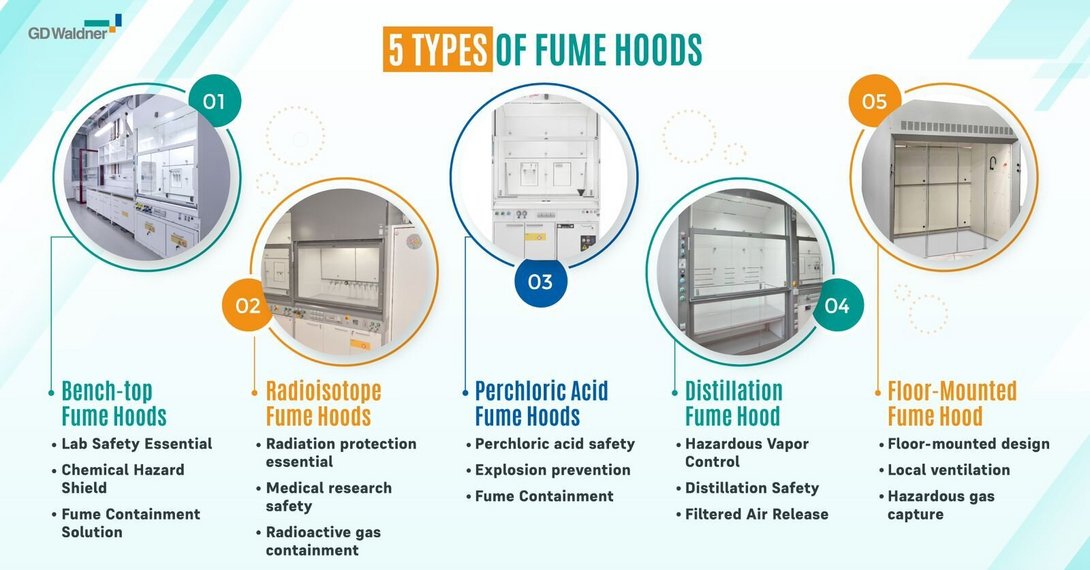A Laboratory Fume Hood is a safety apparatus that removes harmful effluents from lab procedures, protecting personnel and buildings. They're commonly used but often misused, making them crucial yet neglected. Fume hoods come in various shapes, sizes, materials, and finishes to support different chemical procedures. Choosing the right design and configuration is crucial for optimal safety.
- Bench-top fume hoods - A bench-top fume hood is a laboratory equipment that is placed on a bench-top or above a storage cabinet and is available in different sizes to accommodate various chemical processes. It has critical dimensions of length, depth, and interior height, but size is generally determined by the overall width. It can have vertical, horizontal, or combination sash types and can be used for a wide variety of chemical procedures involving low to highly toxic materials. The benchtop hood can effectively contain and exhaust gases, vapor, mists, fumes, and other aerosols with low particle mass.
- Radioisotope Fume Hoods - A radioisotope hood is a type of fume hood used for Beta and Gamma radiation, with a work surface and interior lining made of type 304 stainless steel for easy cleaning and decontamination. It has the general characteristics of a bench-top fume hood, but with a reinforced work surface capable of supporting lead shielding and shielded containers. The load-bearing capacity is at least 200 pounds per square foot and up to a total weight of 1,000 pounds per fume hood or base cabinet section. Horizontal sash panels are not appropriate for this hood type.
- Perchloric Acid Fume Hoods - A perchloric acid hood is a type of bench-top hood that has a coved and welded seamless stainless steel interior lining and non-reactive materials extending through the exhaust system to prevent the build-up of potentially explosive perchlorate salts. It also has a water wash-down system and a specially designed drain outlet. Access holes are not allowed in the liner, but access panels can be placed in the exterior. The design is similar to conventional or bypass fume hoods, but it should never be connected to a manifold system.
- Distillation Fume Hood -A distillation fume hood is a specialized type of fume hood designed for use with tall apparatus and distillation procedures involving small to medium quantities of low to high toxicity materials. It has the same components as a bench-top hood, but provides a greater interior height, enabling the use of larger apparatus. The hood is mounted on a pedestal and can have either vertical rising sashes or horizontal sliding panels. Care must be taken to determine the maximum allowable sash opening and required exhaust flow to ensure effective fume containment.
- Auxiliary Air Fume Hood - The auxiliary air system is used to reduce the consumption of conditioned room air in laboratory fume hoods. The system introduces exterior air to the hood face and aids in diluting heat and fumes generated in the work area. The system must conform to certain requirements such as efficient removal of fumes, capture of specified air ratios with sashes open or closed, and not pressurizing the hood chamber with auxiliary air. Additionally, consideration should be given to pre-conditioning and filtering the auxiliary air.
In conclusion, a laboratory fume hood is an essential safety device that protects laboratory personnel and facilities by eliminating harmful effluents from lab procedures. Each type has its own advantages and limitations, making it necessary to select the right design and configuration based on the lab's specific requirements. A well-chosen fume hood can optimize safety and prevent exposure to hazardous chemicals, making it an indispensable tool for any laboratory. Therefore, careful consideration must be given when choosing the right fume hood to ensure maximum protection for laboratory personnel and facilities.

